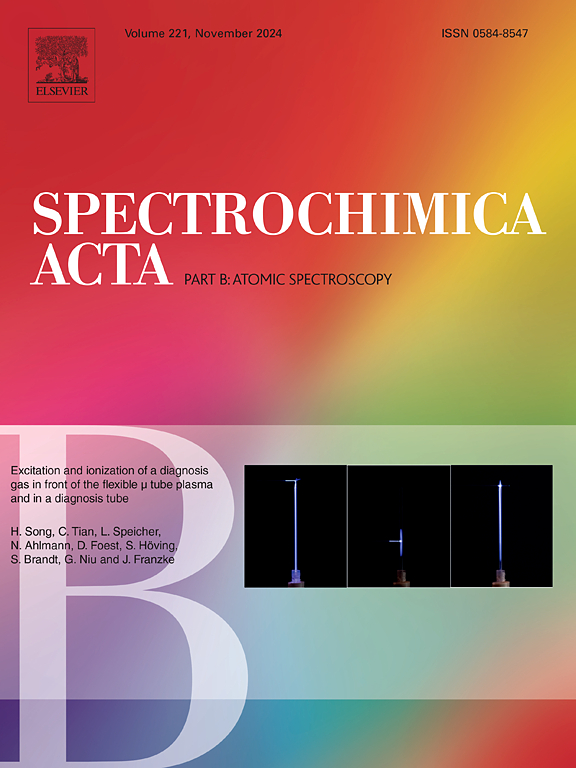激光诱导紫外光谱(LIXS)作为样品氧化瞬态光谱指纹的辐射复合
IF 3.8
2区 化学
Q1 SPECTROSCOPY
引用次数: 0
摘要
研究了热高密度等离子体中 d 块过渡金属和重金属的激光诱导 XUV 光谱(LIXS)重组信号的解卷积。利用自行开发的 XUV 光谱仪,研究了不同电子密度和等离子体温度下镍(Ni)和金(Au)的离子阶段。研究结果表明,特定的离子种类趋于稳定,镍倾向于类氖构型,而金则表现出复杂的 d-f 轨道相互作用。在非局部热力学平衡(NLTE)模拟的支持下,这项研究深入揭示了等离子体电离动力学以及闭壳构型作为氧化态代理的稳健性,从而提高了钼碘氙在材料分析中的应用。本文章由计算机程序翻译,如有差异,请以英文原文为准。

Radiative recombination as a transient spectroscopic fingerprint for sample oxidation using laser-induced XUV spectroscopy (LIXS)
The deconvolution of Laser-Induced XUV Spectroscopy (LIXS) recombination signals for d-block transition and heavy metals, in hot and dense plasmas, was studied. Using a self-developed XUV spectrograph, ion stages of nickel (Ni) and gold (Au) under varying electron densities and plasma temperatures were investigated. The results revealed stabilization of specific ion species, with Ni favoring Ne-like configurations and Au exhibiting complex d-f orbital interactions. Supported by non-local thermodynamic equilibrium (NLTE) simulations, this study provides insights into plasma ionization dynamics and the robustness of closed-shell configurations as oxidation state proxies, enhancing LIXS applications in material analysis.
求助全文
通过发布文献求助,成功后即可免费获取论文全文。
去求助
来源期刊
CiteScore
6.10
自引率
12.10%
发文量
173
审稿时长
81 days
期刊介绍:
Spectrochimica Acta Part B: Atomic Spectroscopy, is intended for the rapid publication of both original work and reviews in the following fields:
Atomic Emission (AES), Atomic Absorption (AAS) and Atomic Fluorescence (AFS) spectroscopy;
Mass Spectrometry (MS) for inorganic analysis covering Spark Source (SS-MS), Inductively Coupled Plasma (ICP-MS), Glow Discharge (GD-MS), and Secondary Ion Mass Spectrometry (SIMS).
Laser induced atomic spectroscopy for inorganic analysis, including non-linear optical laser spectroscopy, covering Laser Enhanced Ionization (LEI), Laser Induced Fluorescence (LIF), Resonance Ionization Spectroscopy (RIS) and Resonance Ionization Mass Spectrometry (RIMS); Laser Induced Breakdown Spectroscopy (LIBS); Cavity Ringdown Spectroscopy (CRDS), Laser Ablation Inductively Coupled Plasma Atomic Emission Spectroscopy (LA-ICP-AES) and Laser Ablation Inductively Coupled Plasma Mass Spectrometry (LA-ICP-MS).
X-ray spectrometry, X-ray Optics and Microanalysis, including X-ray fluorescence spectrometry (XRF) and related techniques, in particular Total-reflection X-ray Fluorescence Spectrometry (TXRF), and Synchrotron Radiation-excited Total reflection XRF (SR-TXRF).
Manuscripts dealing with (i) fundamentals, (ii) methodology development, (iii)instrumentation, and (iv) applications, can be submitted for publication.

 求助内容:
求助内容: 应助结果提醒方式:
应助结果提醒方式:


